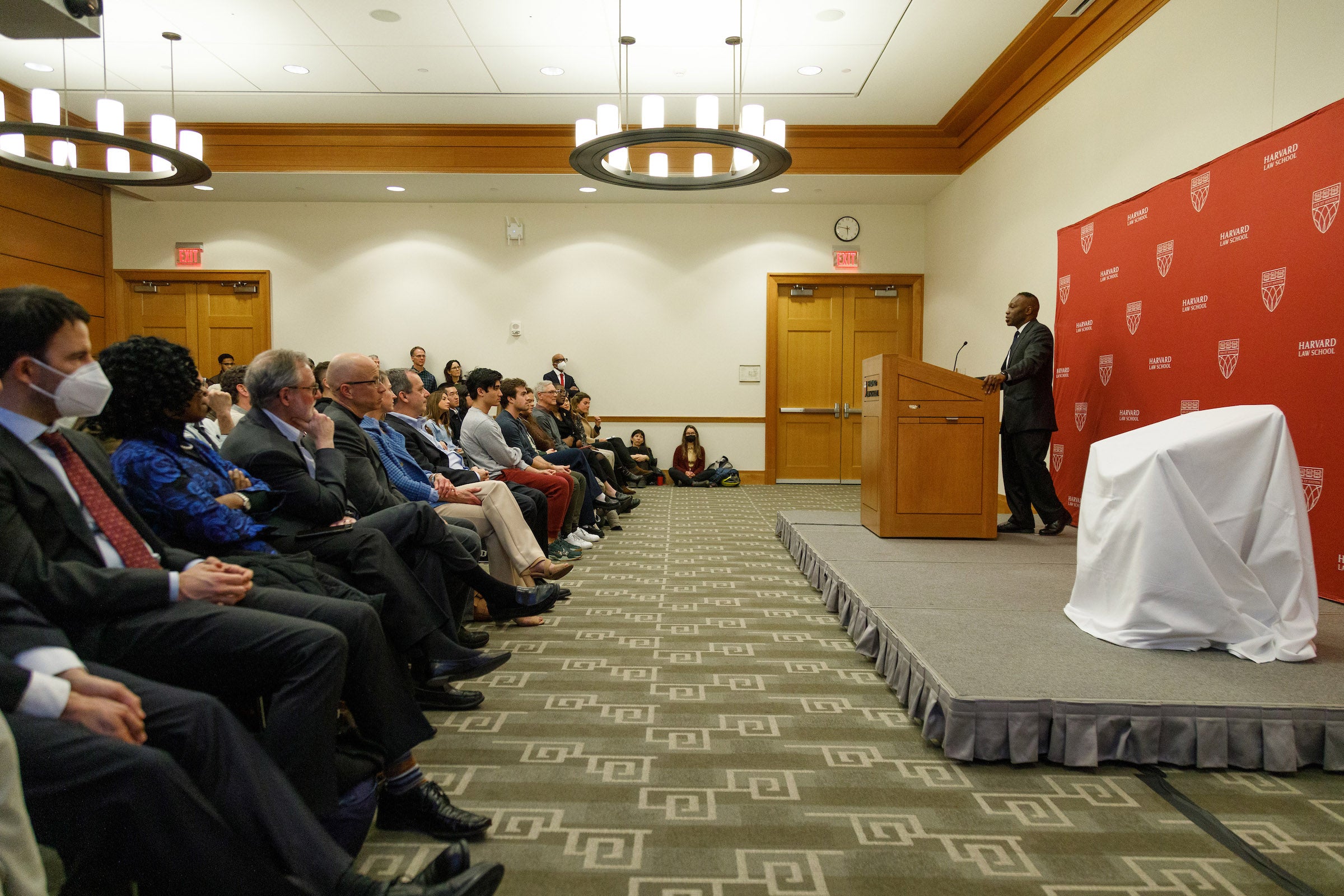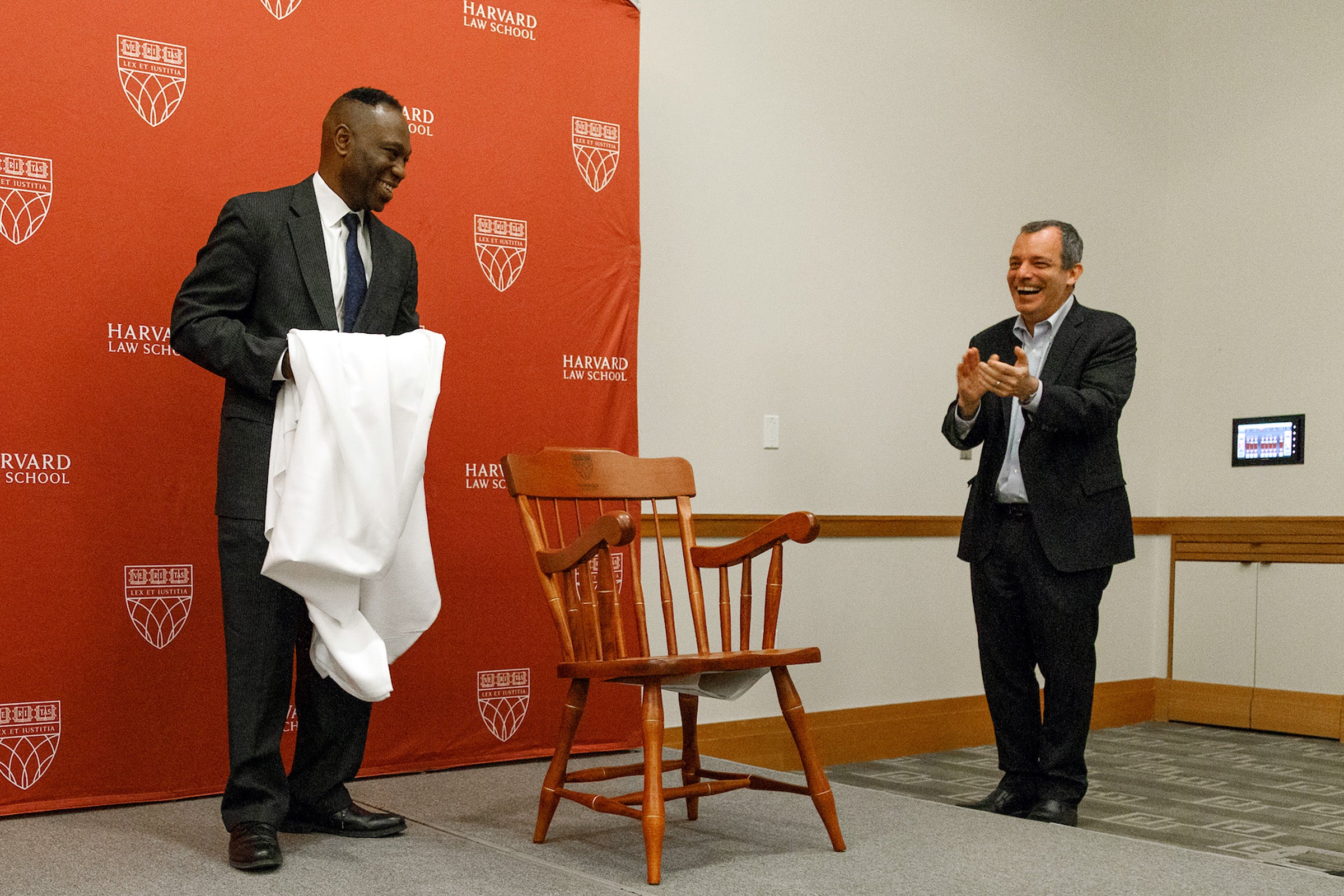“We, as a country, are in the midst of an identity crisis,” said Guy-Uriel E. Charles, the Charles J. Ogletree, Jr. Professor of Law at Harvard Law School at a lecture celebrating his appointment as chair holder last week. “And if we’re not in the midst of one, we’re about to enter one: when we try to figure out who we are, what our values are.”
During his talk, titled “Identity Crisis: The Future of Racial Equality in the Twilight of the Civil Rights Consensus,” Charles described what he views as the agreed-upon approach to equality that emerged after the Civil Rights Movement, how he sees that consensus disintegrating, and what might be in store for the country’s future.
Charles began by sharing his gratitude toward his colleagues, students, staff, and family. He also thanked Professor Ogletree, a “civil rights legend” whose “contributions will serve as a guiding force to the 20th and 21st century.”
Charles opened his lecture by outlining how the “civil rights consensus” came to be. “Until the Civil Rights Movement,” he said, “the United States more or less understood its identity in very narrow racial terms: This was a polity for white people, by white people.” Referring to the infamous Plessy decision, which enshrined legal segregation through the “separate but equal” doctrine, Charles elaborated that, “perhaps until the Civil Rights Movement, Plessy v. Ferguson provided a better description of the American political legal social order than Reconstruction did, and the Reconstruction amendments did, specifically.”
“Until the Civil Rights Movement, the United States more or less understood its identity in very narrow racial terms: This was a polity for white people, by white people.”
Charles said that the outcome of the work of the Civil Rights Movement could have been different. It could have been rejected outright, as it had in the past, or, on the opposite end of the spectrum, the country “could have been forced to rethink the individualistic ethos that undergirds much of the way that we think about the economy — the moral, legal, and social practices.”
We ended up somewhere in between. “We have instead largely opted to continue to think of opportunity and individualistic terms,” said Charles.
During the Civil Rights Movement, institutions “conceded, slowly, haltingly, that the claims by Black and brown people — their claims that they could not be denied the opportunity to compete for the full benefits of a constitutional political economic order, simply because of their race — those claims had to be taken seriously.”


What emerged was what Charles called the “Civil Rights consensus,” whereby “non-white others have special standing and must be accounted for within the constitutional, political, and economic order.” The special standing is because of the nation’s history of white supremacy and racial discrimination, he added.
Examples of the consensus at work include Brown v. Board, the Civil Rights Act of 1965, the Fair Housing Act, and the anti-subordination theory of the Equal Protection Clause, which reflects an “agreement that non-white others had distinct standing because of the history of racial discrimination,” said Charles. “That the polity owes them special solicitude as a matter of formal law, political morality, social inclusion, they must also be accounted for within the constitutional order.”
The resulting law was thus “rigorously committed to formal equality, and haphazardly committed to addressing structural inequality,” said Charles, and operated “largely, though not exclusively, within a Black-white binary.”
“So, allow me to suggest that a feature of the Civil Rights consensus is that we will go so far, and only so far, to achieve equality,” he said. “In other words, the Civil Rights consensus did operate within a racial hierarchy.”
“[The Civil Rights consensus reflected] an agreement that non-white others had distinct standing because of the history of racial discrimination. … That the polity owes them special solicitude as a matter of formal law, political morality, social inclusion, they must also be accounted for within the constitutional order.”
But even that consensus is dissipating, said Charles, pointing to cases at the U.S. Supreme Court challenging affirmative action and sections of the Voting Rights Act. “Today, the fight is largely about the intellectual enterprise: The story that we tell ourselves about who we are as Americans, the stories about our identity, our intellectual traditions, our legacy.”
With an “identity crisis” looming or already underway, “we are starting to regularly and seriously refer to ourselves as a multiracial and multicultural polity,” said Charles. “This means that the Black-white binary can’t hold. It also means, and it’s different from what the prior consensus looks like, that people of color have agency.”
Charles offered a few hypotheses on what may be next as the country continues to grapple with racial inequality. “One possibility is that we coalesce around a class consciousness,” he said. A national or “broad supra-identity” could emerge. Another possibility is that political tribalism or an ideology pitting liberalism against illiberalism could emerge. “It is also possible that we devolve into a type of racial essentialized tribalism.”
Of those options, “some are more worrisome than others,” he admitted.
Knowing this, Charles urged those in the room to use their agency to help determine which direction the country will ultimately take. “My work has been animated by trying to understand what we owe each other as self-governing people, as people who are theoretically committed to the enterprise of democracy. Like other eras before us, we have an obligation to pass on the blessings of liberty to ourselves and to our posterity.”
At the end of the event, John F. Manning ’85, the Morgan and Helen Chu Dean and Professor of Law, presented Charles with his official Harvard Law School chair. During his introduction earlier that evening, the dean praised Charles as a teacher and mentor, and as a “creative, path-breaking, and impactful scholar whose writing has reimagined the critical relationship among voting rights, race, and democracy in America.”



“Sometimes a person joins an institution, and you cannot remember what the institution was like before they got here,” added Manning. “And that’s Professor Charles. In the short time he has been here, he has helped Harvard Law School advance vital priorities and deepen our sense of community. He is wise and insightful. He is generous and kind. He is brave and decent. He is a close and trusted friend.”
In honor of the inauguration of the Ogletree chair, Manning also spoke about the contributions of Charles J. Ogletree, Jr. ’78, the legendary Harvard Law School professor, founder and executive director of the Charles Hamilton Houston Institute for Race and Justice, and a preeminent theorist on race and the law. “Professor Ogletree’s remarkable impact stretches from his service as an attorney advancing civil rights and social justice, to his years as a teacher showing his law students, including by the way, a former U.S. president and first lady, that the law can be an instrument for change.”
Want to stay up to date with Harvard Law Today? Sign up for our weekly newsletter.
